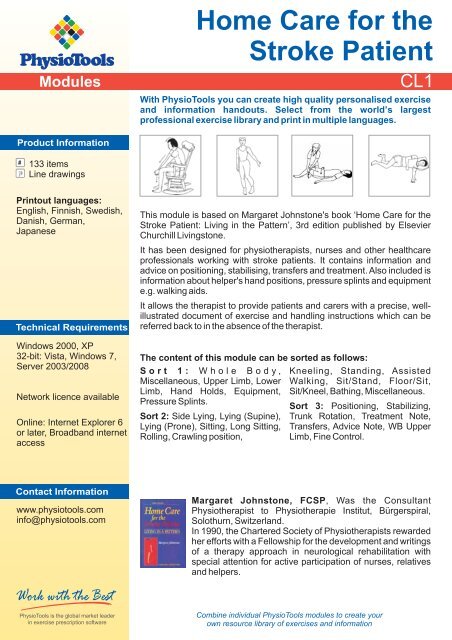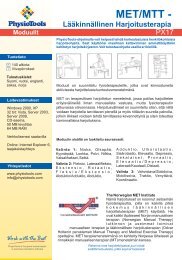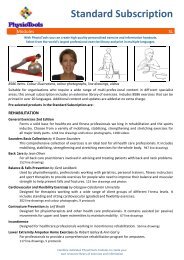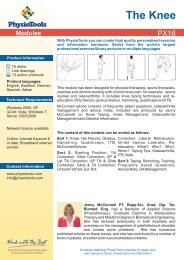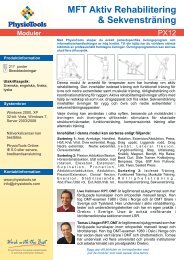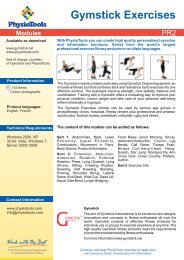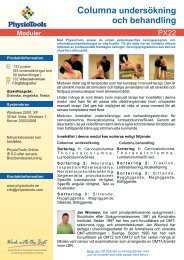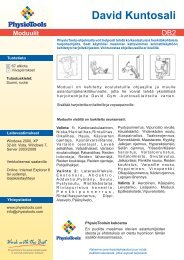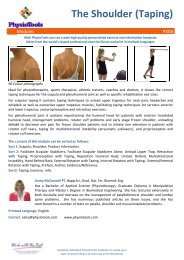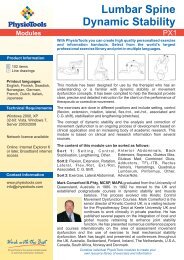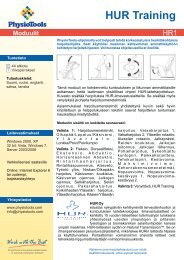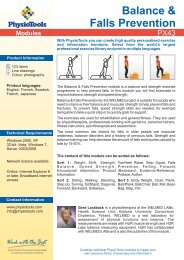CL1 Product Card.pdf - PhysioTools
CL1 Product Card.pdf - PhysioTools
CL1 Product Card.pdf - PhysioTools
Create successful ePaper yourself
Turn your PDF publications into a flip-book with our unique Google optimized e-Paper software.
Modules<br />
Home Care for the<br />
Stroke Patient<br />
<strong>CL1</strong><br />
With <strong>PhysioTools</strong> you can create high quality personalised exercise<br />
and information handouts. Select from the world’s largest<br />
professional exercise library and print in multiple languages.<br />
<strong>Product</strong> Information<br />
#<br />
133 items<br />
Line drawings<br />
Printout languages:<br />
English, Finnish, Swedish,<br />
Danish, German,<br />
Japanese<br />
Technical Requirements<br />
Windows 2000, XP<br />
32-bit: Vista, Windows 7,<br />
Server 2003/2008<br />
Network licence available<br />
Online: Internet Explorer 6<br />
or later, Broadband internet<br />
access<br />
This module is based on Margaret Johnstone's book ‘Home Care for the<br />
Stroke Patient: Living in the Pattern’, 3rd edition published by Elsevier<br />
Churchill Livingstone.<br />
It has been designed for physiotherapists, nurses and other healthcare<br />
professionals working with stroke patients. It contains information and<br />
advice on positioning, stabilising, transfers and treatment. Also included is<br />
information about helper's hand positions, pressure splints and equipment<br />
e.g. walking aids.<br />
It allows the therapist to provide patients and carers with a precise, wellillustrated<br />
document of exercise and handling instructions which can be<br />
referred back to in the absence of the therapist.<br />
The content of this module can be sorted as follows:<br />
Sort 1: Whole Body, Kneeling, Standing, Assisted<br />
Miscellaneous, Upper Limb, Lower Walking, Sit/Stand, Floor/Sit,<br />
Limb, Hand Holds, Equipment, Sit/Kneel, Bathing, Miscellaneous.<br />
Pressure Splints.<br />
Sort 3: Positioning, Stabilizing,<br />
Sort 2: Side Lying, Lying (Supine),<br />
Lying (Prone), Sitting, Long Sitting,<br />
Rolling, Crawling position,<br />
Trunk Rotation, Treatment Note,<br />
Transfers, Advice Note, WB Upper<br />
Limb, Fine Control.<br />
Contact Information<br />
www.physiotools.com<br />
info@physiotools.com<br />
Margaret Johnstone, FCSP, Was the Consultant<br />
Physiotherapist to Physiotherapie Institut, Bürgerspiral,<br />
Solothurn, Switzerland.<br />
In 1990, the Chartered Society of Physiotherapists rewarded<br />
her efforts with a Fellowship for the development and writings<br />
of a therapy approach in neurological rehabilitation with<br />
special attention for active participation of nurses, relatives<br />
and helpers.<br />
<strong>PhysioTools</strong> is the global market leader<br />
in exercise prescription software<br />
Combine individual <strong>PhysioTools</strong> modules to create your<br />
own resource library of exercises and information
You can<br />
place your<br />
logo on the<br />
left or right<br />
side of the<br />
handout<br />
Personal Exercise Program<br />
Your Organisation Name<br />
Your Address<br />
Your Telephone/Fax/Email/Website<br />
You can have more than one header<br />
Provided for : Patient's Name<br />
Provided by : Your Name<br />
Home Care For The Stroke Patient<br />
PREPARATION FOR STANDING WITH A ROCKING CHAIR<br />
Patient uses rocking chair to learn forwards before standing.<br />
He interlaces fingers, straightens arms and keeps shoulder forwards.<br />
The direction of movement is shown by the arrows.<br />
© Pearson Professional Ltd<br />
RECOVERY PATTERN<br />
1. Drawing forwards of shoulder with OUTWARD ROTATION<br />
2. Elbow straight<br />
3. Fingers straight and separated<br />
4. Drawing forwards of the hip with INWARD ROTATION of the leg<br />
5. Hip, knee and ankle bent.<br />
© Pearson Professional Ltd<br />
BACK LYING AND HIP ROLLING<br />
When resting in this position the knees should point to the ceiling. Tap the<br />
inside of the affected knee if it moves outwards to help remind patient about<br />
correct position.<br />
Encourage slow rhythmical knee rolling from side to side.<br />
Start with assistance and gradually withdraw this when possible. Support the<br />
affected leg in a flexed position as necessary.<br />
© Pearson Professional Ltd<br />
LYING ON THE AFFECTED SIDE<br />
If this is uncomfortable for the patient, the affected shoulder has not been<br />
carefully positioned.<br />
Ensure:<br />
Shoulder is not trapped below the body. Affected arm clear of pillow placed well<br />
forwards and shoulder in good outward rotation as illustrated. Arm turned out,<br />
elbow straight, palm uppermost, thumb away from body. Unaffected leg<br />
forwards, affected hip straight with knee bent.<br />
© Pearson Professional Ltd<br />
Printed from <strong>PhysioTools</strong> ®<br />
Your Organisation Name<br />
1/1


